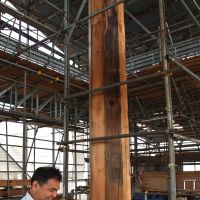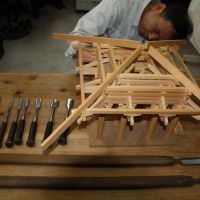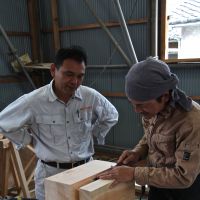The neighborhood of Mukogaoka — literally, "Yonder Hill" — huddles under clouds clustered like violet hydrangea blossoms the morning I arrive to explore.
From Hon-Komagome Station on the Nanboku subway line, I head east with a cautious eye skyward through a rust belt of shuttered stores, by a sundries stand of lightly grimed goods and past flocks of school students in uniforms, their laughter and hair snatched by chill breezes.
However humble in aspect it may be, I soon find that this corner of Bunkyo Ward is rich in temples.
At one, named Seirinji, a gentleman seated at a card table waves me over. "Is there some event?" I ask, fretful that I might be crashing a funeral or something. The man leaps up, and tugs me around to the temple's side yard. There, swathed in construction nets, are 12 pillars supporting the first tier of a building unlike any I've seen. I want a closer look.
Seirinji's head priest, Mitsusada Namba, is summoned. He proudly explains that I am beholding what is destined to be a three-tier pagoda. It is being built using diagrams and techniques employed 1,300 years ago to construct the pagoda at Horyu-ji Temple in Nara, he tells me, referring to the designated national treasure and UNESCO World Heritage Site that's one of the world's oldest wooden structures.
Priest Namba, amiable and hospitable, guides me up a steep work ramp to the second tier. From here, I glimpse the pagoda's shinbashira, its central "heart pillar" comprising a massive trunk of cypress. This single column, astonishingly, is load-free, but it affords the pagoda uncanny stability by limiting — but not preventing — horizontal shifts in its tiers during typhoons and earthquakes.
The shinbashira technique is so socko that Japan's newly tallest structure, the 634-meter Tokyo Sky Tree broadcasting tower that opened last month, also features a steel-reinforced concrete shinbashira at its core.
Seirinji's heart pillar is inked with the names of those supporting the lengthy and costly project. Simply the shinbashira alone, 19 meters of hinoki cypress, is priceless, so the time it takes to collect funds for the project and also to source materials makes progress on the pagoda slow.
Head contractor Toshio Fujino, 58, from the Nishizawa Koumuten engineering firm, invites me into his work shed to see a model of the structure so far. "This helps me understand the complex elements," he says, taking apart the pieces of what looks like a Chinese puzzle and cross-referencing a rare book of pagoda schematics. Both the model and the finished pagoda will use few nails, allowing the structure more give and maintaining the integrity of the massive wooden parts. The no-nails convention has had a lucky consequence in this case.
"Seirinji's pagoda was begun in 1978 by a guy named Joichi Nishioka, almost as a hobby," Fujino tells me. "It was a tremendous start," Fujino says, carefully arranging his immaculate collection of wood chisels on a bench, "but there were structural problems and it had to be entirely dismantled. We plan to use as much of his original materials as we can, though."
I peek into the pagoda's hollow once again, watching as Fujino's team laboriously carve daitō — blocks designed to bear 15 tons of pressure each. In wood alone, the pagoda will weigh 77.5 tons, and once it's roofed with heavy ceramic tiles its 16 daitō will be tested.
Given the relative swiftness with which things are built in Japan, I wonder if Fujino, who has already invested four years of his life in the pagoda, feels frustrated by the protracted pace. "It's by no means a speedy job," he concedes, "but there are only about 200 major pagodas in Japan, and only 50 of this size. I am extremely grateful to have this be my life's work." I nod with appreciation.
"I want the head priest to see it completed," Fujino adds, "so I hope we'll finish within the next 10 years."
I keep it to myself that Priest Namba looks like the kind of man who could patiently wait 25 years, if necessary.
Aware that I am today's construction impediment, I thank Fujino for his time and, inhaling a last lungful of fresh wood fragrance, launch off in search of lunch.
The pickings are slim. I wander back west toward the station and am about to settle for a convenience-store riceball when I stumble on an intriguingly narrow lane lined with trees, bamboo fences and lanterns that threads its way between tall office buildings.
At the path's end, I find a tofu restaurant named Goemon in a tiny idyll of its own. A few city eateries have decent scenery, but few if any equal the design of Goemon. Varying levels of glistening, freshly washed stones support pavilions with discreet individual dining rooms overlooking a waterfall and carp pond. Graceful maples and colored lanterns shift serenely in the breeze. The view from the uppermost dining platform is like gazing down into a "Genji Monogatari" e-maki (an illustration from Shikibu Murasaki's 11th-century novel, "The Tale of Genji").
I order one of the luncheon sets (¥2,000 to ¥3,500) and chat with three generations of the Ishikawa family who run Goemon. Owner 77-year-old Ayako Ishikawa tells me that her late husband, Shizue Daiyu, a professional kiyomoto (lyrical kabuki narrator), designed the grounds 48 years ago.
I lose count of the dishes. Though I love tofu, the procession of fried, steamed, grilled and chilled versions served up one after another is more than I can finish. On my way out, Ayako's daughter, Kyoko, mentions that a man who makes yoroi (samurai armor) and kabuto (helmets) lives in the area. I thank her for this tip, but without an address my hopes of locating him are slim.
As I visit the area's various thickly wooded temple precincts, the sun emerges and awakens mosquitoes. Armor would come in handy, I think, trying to outpace the pests, but my search for the artisan is in vain.
Resigned, but with tomorrow's breakfast in mind, I pop into a bakery. A customer is telling the proprietor that her house is "precisely 256 steps from here." Would any of those steps take her near a helmet-making artisan, I ask, making polite, though bizarre, conversation. "Why yes," she says, "his daughter and mine went to school together."
Hideko Fujita has a wry sense of humor and an obvious fascination with numbers. "I'm 82," she says, as she leads me to the home of artisan Tomomi Kato, "but I fancy I could pass for 81." After introducing me to this warriors' outfitter, she waves goodbye and continues the remaining paces to her home.
Kato, a spry 78-year-old, shows me into his work studio, and asks me how many hours I have. Hours? "Yes," he says. "Making a kabuto requires skills in all kinds of materials — leatherworking, metalworking, silk weaving, lacquering, etc. etc. — and you'll need hours to even glimpse the process."
I sign on for the hours-long intro, and soon learn that the miniature reproductions Kato creates are no cheap ornaments, but faithful and intricate reconstructions using age-old authentic techniques from each helmet's original period. They run anywhere from ¥200,000 to ¥1 million, depending on the materials and intricacy of design.
Kato teaches me how a helmet's shikoro (protection for the back of the wearer's neck) reveals its date: earlier ones, made of leather and silk, were effective against arrows; while later ones made of metal plates were designed to fend off swords.
I also learn that seven animal leathers (horse, cat, dog, deer, goat, cow and monkey) are used in the construction of a warrior's suit of armor — though without beginning to touch on the complexities of lacquering and polishing the leather scales, or lacing them with silk cord that's so strong but fine because each thread is comprised of 125 strands.
I ask Kato if he has ever made a full-size suit of armor. "Yes," he replies. "It took me, my apprentice, and son three years to create and it cost ¥30 million in materials." I asked if he tried it on. "It's actually too heavy for modern men to wear; we are too weak," he says.
Nonetheless, Kato has the strength to power through 18-hour days to meet an order deadline. Being able to draw on three generations of know-how, and his own work experience since age 11, he is passionate about his skills and happy to hand them on to apprentices. "If I teach them strictly for a mere two years," he says, "I can then set them free. What they have learned with their bodies, they will never forget."
More than four hours later, Kato has lost neither his patience nor his desire to teach me as much as possible, but my head is reeling from an onslaught of unfamiliar armor jargon.
Sensing this, Kato suggests a break. In his living room as the late-afternoon sun pours in, it's reflected in coffee served by his wife. She shows me a purse, a gift from her husband, that's made entirely of traditional armor. Now knowing the months of work that went into this present, I realize that for all his armor-fashioning skills, Kato has left his heart vulnerable. Therein is his greatest source of strength, I think.
Kit Nagamura will take a break in July, but "Backstreet Stories" will be back in August.





